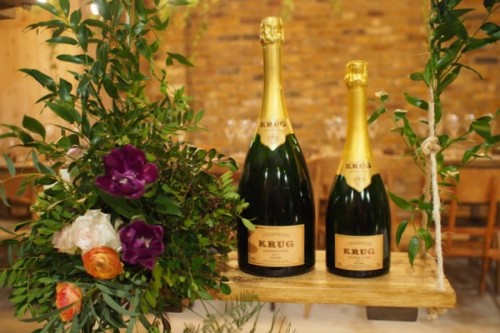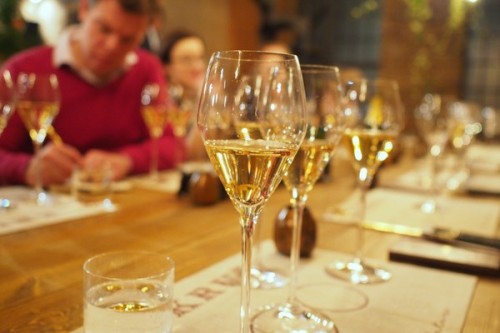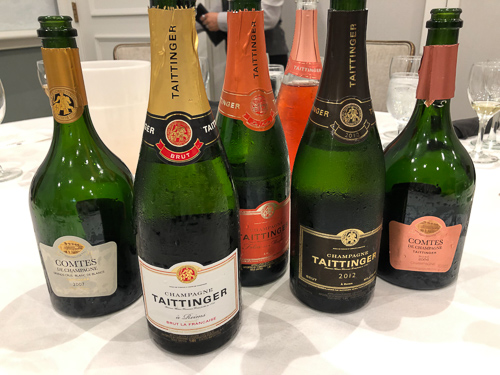
Krug 2002 has finally been launched. On Tuesday evening a group of us gathered in a studio in Shoreditch which had, for a week, been turned into the home of Krug. It was quite pretty. Eric Lebel (above left), who’s been chef de cave here for 18 years was presenting, along with Olivier Krug and brand manager Jessica Julmy (who’s in between them).

‘At Krug, the vintage is the story of the year,’ said Eric. ‘At no point will there be a focus on the best in class. There is no hierarchy in our Champagnes. They are the same quality.’ Krug’s vintage wines represents 10% of production, and Krug’s production (not talked about openly) is 0.2% of all of the Champagne region’s.

We began with a recap of the 2003. Frost in April took 40% of the crop. This was a very hot year with early ripening, especially for the Chardonnays, and the harvest date of 23 August meant that it was the first time there had been an August harvest since 1822. There were lots of over-ripe grapes, but there were some plots that were underripe because the heat had just stopped photosynthesis. The Krug plot-by-plot approach meant that they could leave the under-ripe plots and then do a second round of harvesting in October. Many of the late-ripening plots were Meunier. ‘Let’s see what we can make with such an interesting year,’ Eric said to himself. ‘There was a freshness that was very surprising.’ The final blend was 29% Chardonnay, 25% Pinot Noir and a whopping 46% Pinot Meunier.

Champagne Krug 2003
ID: 114002, which means this was disgorged in the first quarter of 2014. Tight, still, with bright acidity and some pithy notes. This is not what you’d expect from 2003. Distinctive toast and citrus, a bit of white peach and some hazelnut, with nice brightness. This is taut and direct with a crisp, somewhat clipped finish. 92/100
‘2002 was everything you wanted to make a grand Champagne,’ says Eric. ‘Everything was in abundance, and it was a close managing process to make sure it wasn’t too much: you had to reign it in.’ He says that when he was blending the base wines, each individual wine tasted like a blend of different wines. ‘They were so generous and expressive. Everything about 2002 was a question of abundance, energy and charisma.’
Each year there are some 250 lots of wine to taste, and Olivier and Eric tend to taste the wines daily: they’ll typically look at 15 wines each day. Theirs is a parcel by parcel approach. ‘Terroir can be erased by the volume of vinification,’ says Olivier. ‘If three pressings come in, totalling 60 hl, in every other house they would end up in the same vat,’ he says. ‘Here, they will be three wines. We are keeping the individuality of the terroirs and bringing it to the blend. This is the major difference between Krug and the other houses.’

Champagne Krug 2002
ID: 414071, disgorged 4th quarter of 2014. Fine, multidimensional, focused aromatic nose with some toasty notes. Complex pear, peach and citrus flavours with lovely complexity. Real breadth but also some focus. It’s certainly very rich in style and a bit showy, with complex grapefruit, lemon, toast and hazelnut characters at its core. Showy but ultimately quite serious. 95/100
Then we looked at a couple of Grand Cuvées.
Champagne Krug Grand Cuvée NV
Current release, edition 163, ID 414067, disgorged fourth-quarter 2014, 183 different wines ranging from 1990 to the base wine of 2007. Toast, pears, citrus and a bit of peachy richness. Very refined, but not terribly fizzy (this was shared with all the bottles sampled tonight). There’s a lovely balance of freshness and richness, with nice fruit and acidity alongside the richer notes. 94/100
Champagne Krug Grand Cuvée NV
This is edition 158, based on the 2002 vintage. 58% 2002, 42% reserve wines. It was disgorged recently, but normally GC has six years on the lees and one year in bottle before release. Fine toast, butterscotch and fresh baked bread notes, as well as some nuts and herbs. Lovely refined toastiness here, with great finesse and balance. A truly beautiful wine. 95/100
